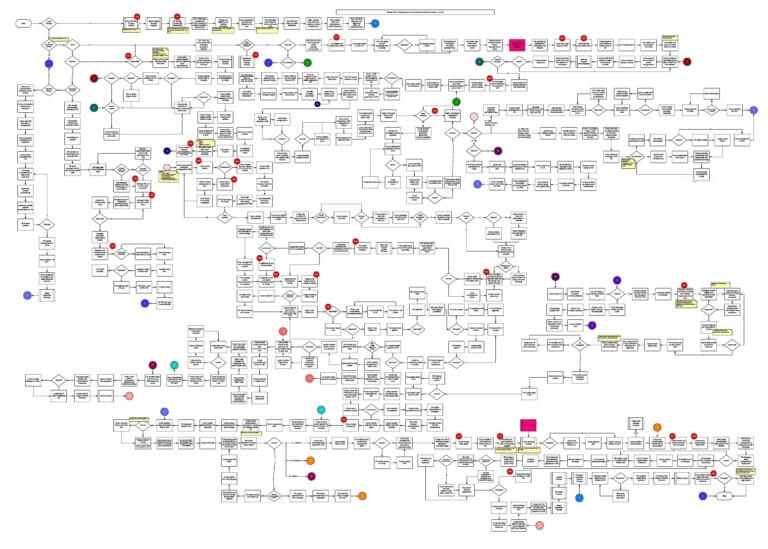Everyone Who Maps Workflows—From AI Builders to Business Pros
Business process mapping delivers undeniable value: enhanced visibility, streamlined operations, better collaboration, and faster onboarding. But let's be honest—creating those maps is often tedious, complicated, and time-consuming. Tools that promise to help frequently end up as digital shelf-ware because they're either too complex for everyday users or too disconnected from modern AI workflows. FlowZap was built to fix both problems.
The Modern FlowZap Audience: Three Distinct Communities
1. AI Builders and Solopreneurs
If you're building AI agents, you're constantly designing and iterating on workflows. You need to visualize:
- How your agent makes decisions
- Where handoffs happen between systems
- What steps can be automated versus require human input
Your challenge: You don't want to wrestle with diagramming syntax or spend hours manually creating flowcharts. You want to describe your workflow and see it visualized instantly.
FlowZap's solution: Describe your process in plain English to Claude, ChatGPT, DeepSeek, or any AI assistant, and it generates FlowZap Code automatically. Modern AI browsers like Comet, Gemini, Genspark, Fellou, and Dia integrate seamlessly with FlowZap's “Generate FlowZap Code with AI” modal. Your agent workflow goes from concept to diagram in seconds.
Real use case: A solopreneur building a customer support agent uses Claude to generate FlowZap Code describing ticket triage, escalation paths, and resolution workflows. The entire process map is ready in under two minutes—no manual diagramming required.
2. Developers and Technical Teams
You're integrating workflow automation into your applications. You need a diagramming backend that:
- Speaks JSON-RPC and HTTP (no proprietary SDKs)
- Works with any LLM agent, not just one vendor
- Provides clean, shareable diagram URLs
- Handles authentication and rate limiting without vendor lock-in
Your challenge: Existing diagramming APIs are either closed ecosystems, overly complex, or focused on pixel-perfect design rather than structured workflows.
FlowZap's solution: Our public MCP (Model Context Protocol) server at flowzap.xyz/mcp provides dead-simple JSON-RPC 2.0 API access. Any agent—Claude, ChatGPT, DeepSeek, Qwen, Grok—can generate, update, and share business process diagrams. No plugins. No waiting. Just standard HTTP requests.
Real use case: A development team building a workflow orchestration platform uses FlowZap's MCP API to generate interactive diagrams for their users. Instead of building diagramming UI from scratch, they leverage FlowZap's visual editor and simply pass FlowZap Code via API calls.
3. Business Process Professionals and Everyday Heroes
You're not a developer or AI specialist. You're a:
- Customer Service Rep handling complaint resolutions and needing to visualize escalation paths
- Accountant mapping invoice processing to ensure accuracy
- Order Manager documenting order fulfillment from receipt to delivery
- HR Manager creating employee onboarding or performance review flows
- Warehouse Manager outlining inventory processes to reduce errors
Your challenge: BPMN notation is too complex. Enterprise tools like Miro and Lucidchart are overkill and expensive. You just need to quickly map your process, train team members, share knowledge when someone's on vacation, and identify bottlenecks.
FlowZap's solution: Our simple FlowZap Code syntax reads like a structured checklist—no programming background needed. Organize your process into lanes (teams/roles), add steps (nodes), and connect them (edges). Auto-layout handles the visual arrangement. If you can describe your workflow, you can diagram it in FlowZap.
Real use case: An HR coordinator needs to document the new hire onboarding process. She writes simple FlowZap Code listing each step—send offer letter, collect documents, schedule orientation, assign mentor—and connects them. The visual diagram becomes the training reference for the entire team, reducing onboarding time by 30%.
Common Threads: What All FlowZap Users Value
- Speed: Generate diagrams in minutes, not hours
- Simplicity: No BPMN certification required
- Collaboration: Share and iterate with your team
- AI-native workflows: Seamless integration with modern LLM tools
- Accessibility: Affordable pricing without enterprise bloat
Why Traditional Tools Fall Short
BPMN Complexity Trap: Nearly 60% of BPM professionals rate their BPMN skills as average or below average. FlowZap sidesteps this entirely with intuitive, plain-language syntax.
Enterprise Overkill: Miro and Lucidchart offer hundreds of templates and integrations, but that complexity confuses non-experts. User reviews consistently mention “crowded interfaces” and “learning curves.” For small teams, costs quickly escalate ($8–10/user/month adds up), and 40% of SMBs don't even have a full-time IT employee to manage these tools.
Disconnected from AI: Traditional diagramming tools weren't built for the AI era. They don't integrate with LLM agents, don't generate diagrams from natural language, and don't provide API-first workflows.
FlowZap's Unique Position: The Bridge Between AI and Business Process Mapping
- AI-assisted: Generate diagrams from plain-English prompts
- Code-friendly: Structured DSL that's human-readable and machine-parseable
- Universal: Open MCP server works with any AI agent
- Practical: Built for real business needs, not enterprise bloat
Real-World Impact
Teams utilizing collaborative process mapping see significant increases in engagement and productivity. Projects with excellent change management are 7x more likely to succeed. Companies implementing process standardization experience 15% fewer errors and 20% higher productivity. FlowZap amplifies these benefits by removing friction—the tedious, complicated parts that prevent people from documenting processes in the first place.
So, Who Is FlowZap For?
You—if you:
- Build or work with AI agents
- Integrate workflow automation into applications
- Map business processes without a technical background
- Value speed, simplicity, and AI-native workflows
- Want process mapping that doesn't require a PhD in notation standards
